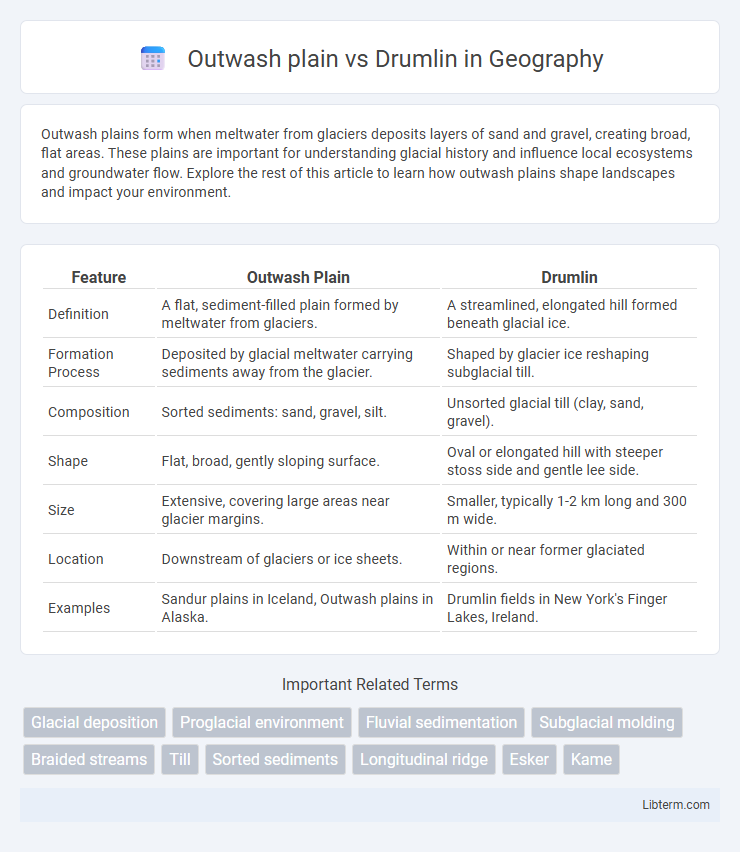Outwash plains form when meltwater from glaciers deposits layers of sand and gravel, creating broad, flat areas. These plains are important for understanding glacial history and influence local ecosystems and groundwater flow. Explore the rest of this article to learn how outwash plains shape landscapes and impact your environment.
Table of Comparison
| Feature | Outwash Plain | Drumlin |
|---|---|---|
| Definition | A flat, sediment-filled plain formed by meltwater from glaciers. | A streamlined, elongated hill formed beneath glacial ice. |
| Formation Process | Deposited by glacial meltwater carrying sediments away from the glacier. | Shaped by glacier ice reshaping subglacial till. |
| Composition | Sorted sediments: sand, gravel, silt. | Unsorted glacial till (clay, sand, gravel). |
| Shape | Flat, broad, gently sloping surface. | Oval or elongated hill with steeper stoss side and gentle lee side. |
| Size | Extensive, covering large areas near glacier margins. | Smaller, typically 1-2 km long and 300 m wide. |
| Location | Downstream of glaciers or ice sheets. | Within or near former glaciated regions. |
| Examples | Sandur plains in Iceland, Outwash plains in Alaska. | Drumlin fields in New York's Finger Lakes, Ireland. |
Introduction to Outwash Plains and Drumlins
Outwash plains, also known as sandurs, form from glacial meltwater deposits, characterized by layered sands and gravels spread over broad, flat areas. Drumlins are streamlined, elongated hills composed of glacial till, shaped beneath moving ice sheets and oriented in the direction of ice flow. Both landforms are integral features of glacial landscapes but differ fundamentally in composition and formation processes.
Formation Processes: Outwash Plains Explained
Outwash plains form from sediment deposited by meltwater flowing from glaciers, creating broad, flat areas composed mainly of sand and gravel sorted by water streams. In contrast, drumlins are streamlined, elongated hills of glacial till shaped beneath moving ice, indicating ice flow direction. The key distinction lies in outwash plains being meltwater sediment deposits, while drumlins result from direct glacial sculpting of subglacial till.
How Drumlins Are Formed
Drumlins are streamlined hills formed by glacial ice reshaping underlying sediments or bedrock as glaciers advance. They typically consist of compacted till or glacial debris molded into elongated shapes indicating ice flow direction. In contrast, outwash plains are flat areas formed by meltwater depositing sorted sediments beyond the glacier's terminus.
Key Geological Differences
Outwash plains are formed by meltwater deposits from glaciers, characterized by stratified sand and gravel spread over large, flat areas, while drumlins are streamlined, elongated hills composed of glacial till shaped beneath moving ice. Outwash plains exhibit well-sorted sediments due to water transportation, contrasting with the poorly sorted, compact glacial till found in drumlins. The formation process distinguishes outwash plains as depositional landforms, whereas drumlins result primarily from glacial erosion and reshaping of underlying sediments.
Sediment Composition: Outwash Plain vs Drumlin
Outwash plains consist primarily of well-sorted sand and gravel sediments deposited by meltwater streams, resulting in layered, stratified deposits. Drumlin sediment composition is typically unsorted glacial till, containing a mix of clay, silt, sand, gravel, and boulders deposited directly by glacial ice. The key difference lies in the outwash plain's water-sorted sediments versus the drumlin's heterogeneous, ice-molded till.
Landscape Features and Appearance
Outwash plains are broad, flat landscapes formed by sediment deposition from glacial meltwater, characterized by stratified sand and gravel layers with braided stream channels. Drumlin fields consist of streamlined, elongated hills composed of glacial till, aligned in the direction of ice movement and typically oval or tear-shaped in appearance. The contrasting topographies reflect the depositional environment, with outwash plains displaying smooth, extensive surfaces and drumlins exhibiting localized, raised landforms.
Hydrological Influence and Patterns
Outwash plains exhibit extensive permeability due to well-sorted sands and gravels, promoting rapid infiltration and influencing groundwater recharge and surface water flow patterns. In contrast, drumlins consist of compact glacial till, which reduces permeability and directs surface runoff around their streamlined forms, altering local drainage networks. The contrasting sediment composition between outwash plains and drumlins significantly affects hydrological dynamics and watershed behavior in glaciated landscapes.
Ecological Impact of Outwash Plains and Drumlins
Outwash plains, formed by glacial meltwater deposits, create well-drained, gravelly soils that support diverse pioneer vegetation and specialized aquatic habitats crucial for biodiversity. Drumlins, streamlined hills composed of compact glacial till, influence local drainage patterns and microhabitats, often providing unique elevated niches for plant and animal species adapted to varied moisture conditions. Both landforms significantly shape regional ecosystems by fostering habitat heterogeneity and influencing water flow, soil composition, and vegetation distribution.
Global Distribution and Examples
Outwash plains, formed by sediment deposited by meltwater from glaciers, are widespread in regions such as the northern United States, Canada, and parts of northern Europe, with notable examples including the Sandur plains in Iceland and the outwash areas in Montana's Glacier National Park. Drumlin fields, streamlined hills created by glacial ice reshaping underlying sediment, occur prominently in areas like the Finger Lakes region of New York, southern Ontario in Canada, and parts of Ireland, exemplified by the Drumlin Belt in County Mayo. Both landforms serve as key indicators of past glacial activity but differ in formation processes and morphology across global glaciated landscapes.
Importance in Glacial Geomorphology
Outwash plains, formed by glacial meltwater depositing sorted sediments, play a crucial role in understanding sediment transport and deposition patterns in glacial environments. Drumlin fields, characterized by streamlined hills composed of glacial till, provide key insights into ice flow dynamics and subglacial deformation processes. Comparing outwash plains and drumlins enhances the reconstruction of past glacial movement and landscape evolution in glacial geomorphology.
Outwash plain Infographic

 libterm.com
libterm.com